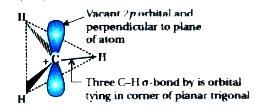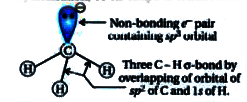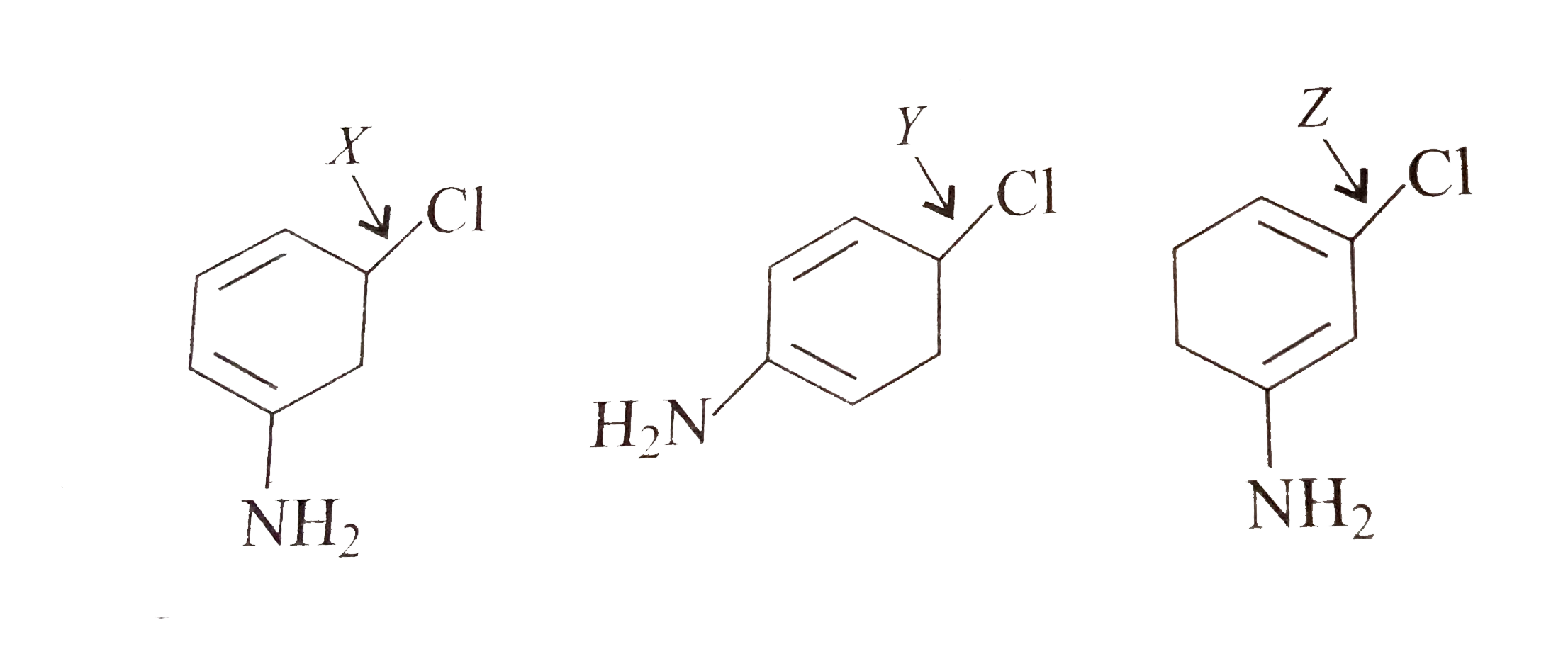Explain heterolytic cleavage of organic compound (b) Carbanions by examples
Definition: When a covalent bond breaks in such a way that both the electrons of the covalent bond (i.e. shared pair) are taken away by one the bonded atoms, the mode of bond cleave is called heterolytic fission. After heterolysis, one atom has a sextet electronic structure and a positive charge and the other, a valence octet with at least one lone pair and a negative charge.
Heterolytic fission producing carbocation: e.g. Heterolytic cleavage of bromoethane will give +CH3 (positive ion) and B−r (negative ion).

Both electron of C-Br bond are transfer on Br. So, the non-bonding electron pair, octet and negative charge on Br. A species having carbon atom possessing sextet of electron and +1 positive charge is called a carbocation. This +CH3 ion is known as a methyl cation or methyl carbonium ion. Positively charged carbon of +CH3 possessing sp2 hybridisation

These carbocations have trigonal planar shape because it derived from the overlap of three equivalent C (sp2) hybridised orbitals with is orbital of each of the three hydrogen atoms. Each bond may be represented as C(sp2), H(IS) sigma bond. The remaining carbon orbital is perpendicular to the molecular plane and contains on electron.
(b) Heterolytic fission producing carbanion: The heterolytic cleavage can also give species in which carbon gets the shared pari of electron and obtain negative charge containing species. e.g., When group Z attached to the carbon leaves without electron pair, the methyl anion (H3C−) is formed

Carbon species carrying a negative charge on carbon atom is called carbanion. On carbanion carbon the octet and non-bonding e− pair present and it possessing sp2 hydridisation, so its shape is tetrahedral

Carbanions are also unstable and reactive species.
(c ) Heterolytic cleavage and reaction mechanism: The organic reactions which proceed through heterolytic bond cleavage are called ionic or heteropolar or just polar reactions
Topper's Solved these Questions
- ORGANIC CHEMISTRY SOME BASIC PRINCIPLES AND TECHNIQUESBOOK - KUMAR PRAKASHANCHAPTER - ORGANIC CHEMISTRY SOME BASIC PRINCIPLES AND TECHNIQUESEXERCISE - Section A (Fundamental Concepts in Organic Reaction Mechanism)
40 Videos
- ORGANIC CHEMISTRY SOME BASIC PRINCIPLES AND TECHNIQUESBOOK - KUMAR PRAKASHANCHAPTER - ORGANIC CHEMISTRY SOME BASIC PRINCIPLES AND TECHNIQUESEXERCISE - Section -A(Methods of Purification of Organic Compounds)
44 Videos
- ORGANIC CHEMISTRY SOME BASIC PRINCIPLES AND TECHNIQUESBOOK - KUMAR PRAKASHANCHAPTER - ORGANIC CHEMISTRY SOME BASIC PRINCIPLES AND TECHNIQUESEXERCISE - Section A (Isomerism)
12 Videos
- HYDROGENBOOK - KUMAR PRAKASHANCHAPTER - HYDROGENEXERCISE - Section-D NCERT Exemplar (Long Answer)
8 Videos
- QUESTION ASKED IN JEE -2018BOOK - KUMAR PRAKASHANCHAPTER - QUESTION ASKED IN JEE -2018EXERCISE - MCQ
10 Videos
Similar Questions
Knowledge Check
The heterolytic cleavage of a C-Cl bond produces
ATwo free radicalsBTwo carbonium ionsCTwo carbanionsDOne cation and one anionHeterolytic cleavage of a covalent bond gives only,
ACationic speciesBAnionic speciesCBoth the aboveDFree radicals.Find out correct order for the energy requried for heterolytic cleavage of indicated C−Br bonds forming carbocation :
 AZ>Y>XBX>Y>ZCY>X>ZDZ>X>Y
AZ>Y>XBX>Y>ZCY>X>ZDZ>X>Y
Find out correct order of energy required for heterolytic cleavage of indicated C−Cl bonds forming carbocation :

View SolutionFind out correct order for the energy required for heterolytic cleavage of indicated C-Cl bonds forming carbocation :

View SolutionFind out correct order for the energy required for heterolytic cleavage of indicated C−Br bonds forming carbocation :

View SolutionThe bond that undergoes heterolytic cleavage most readily is
View SolutionPassage
Organic compounds mainly consist of covalent bonds. The electron pair in these covalent bonds may undergo displacement either of their own or under the influence of other species. The cleavage of covalent bond between two atoms takes place in homolytic or heterolytic fashion. The homolytic fission results into free radicals while heterolytic fission results into carbocations and carbanions. These are also called reaction intermediates and are attacked by electrophiles and nucleophiles. The electrophiles seek electron rich sites while nucleophiles seek electron deficient sites.
Answer the followings Questions :
The most stable carbanion among the following is
View Solution
